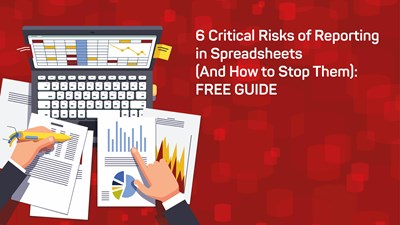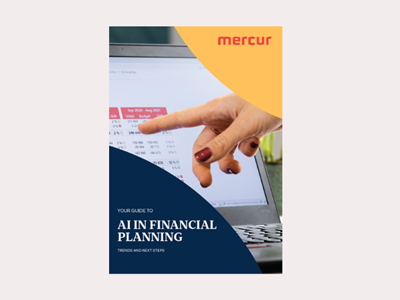
How to Build an Effective Budgeting Process: Step-by-Step Guide for Finance Teams
Having a specific budgeting process helps organisations control spending and make smart business decisions. However, budgeting can be challenging when income is unpredictable, costs change suddenly or there’s poor communication and unrealistic planning.
That’s why it’s important to have a clear, realistic process that involves the right people and allows for regular tracking. When done well, budgeting helps organisations stay financially on course, even when things don’t go exactly as planned.
In this guide, we’ll cover how to pull last year’s numbers, set clear targets, assign funds and keep things on track so you avoid surprises and stay focused on your goals.
What Is a Budgeting Process and Why It Matters
A budgeting process is a number of steps an organisation uses to plan its finances for a future period. It turns business goals into a financial plan by forecasting revenues, estimating costs and allocating funds to projects and departments.
Instead of relying on guesswork or outdated spreadsheets, a good budgeting process uses historical results and collaboration to set realistic targets. It ensures the company knows where resources will go and what constraints it will face.
Create a Budgeting Process Step by Step
Here is how to create a reliable budget process that you can use for years to come:
Step 1: Gather Historical Data and Review Past Budgets
Before you start setting new targets, look at what happened last year. Pull your profit and loss statement, expense reports and any notes on unexpected changes. Compare what you planned to spend with what you actually spent.
Look for gaps or surprises – did revenue dip in the second quarter? Did software costs jump unexpectedly? Noticing these patterns early helps you avoid repeating the same mistakes and plan better for the year ahead.
Pro tip: If spreadsheets are slowing you down, try Mercur’s budgeting software and make automatic calculations.
Step 2: Set Objectives and Scope
Once the data is in hand, clarify the goals of the budget and who will be involved. This usually means defining top-line goals (such as revenue growth or cost savings targets) and scoping which departments or projects the budget will cover.
In practice, finance leaders will meet with senior management and department heads to align on priorities. For instance, if the company aims to grow by 10%, sales and marketing budgets might need extra resources.
Step 4: Allocate and Build the Budget
Now comes the detailed budgeting: allocate the projected funds across cost centres, projects and departments. This means deciding exactly how much each team can spend on salaries, marketing, equipment, etc., and ensuring total outlays match the revenue forecast (or allowed deficit).
In practice, you may find the first draft unbalanced (expenses exceeding revenues, for example), which means revisiting assumptions or reallocating funds until the plan is coherent and aligned with strategy
Step 5: Monitor and Adjust
Once the budget is approved, the real work begins. Track actual income and expenses each month and compare them to your budget using proven management reporting practices. If something is off, like sales coming in lower or costs rising unexpectedly, dig into why.
The goal isn’t just to catch problems but to fix them early. Maybe a department needs to cut back, or maybe you need to update your forecasts. Schedule monthly check-ins so budget reviews become routine, not a surprise.
Tips to Make Budgeting Work for You
To get the most from your budgeting process, follow these best practices for budgeting:
Make budgeting a group work: Involve the entire team from the start and be transparent about goals.
Base predictions on data: Always use actual financial results as your starting point. Avoid wishful thinking – instead, test assumptions and document them.
Be prepared for unexpected changes: Don’t treat the budget as fixed the moment it’s approved. Set aside contingency or plan alternative scenarios.
Document everything: Have a clear timeline and document the process. Avoid overly complex spreadsheets that others can’t understand.
Watch Out for These Budgeting Pitfalls
Here are some common pitfalls to avoid when planning your budget:
Starting too late: Budgeting usually spans several months. If you wait until the last minute, you’ll rush through steps and increase errors.
Ignoring collaboration: A budget created without consulting the rest of the team will be unrealistic.
Unrealistic expectations: You may have a certain target in mind that doesn’t factor in all possible costs or losses, possibly going over budget.
Speed up the Budgeting Process with Mercur Business Control®
Mercur is the market-leading solution for corporate performance management and business intelligence. Here’s what you get when you integrate and implement Mercur Business Control in your organisation:
Choose the level of detail you need for the budget
Help employees understand the business model with a driver-based budgeting
Link budgets to actuals already in the planning work
Speed up your budget process and increase its value to your organisation
Involve employees in the budget process with target and key performance indicators.
We have helped hundreds of leading organisations with different challenges for over 40 years. Request a free demo and unlock the power of budgeting automation.
Contact us for more information on how we can help you with your budgeting process
Frequently Asked Questions
What is the budgeting process?
It’s the steps you take to build a realistic spending plan: review past results, forecast income and costs, divide funds by function and then track actuals against your plan to stay on course.
What are the steps of the budget planning process?
Here is a straightforward way to plan your budget:
Gather and analyse last year’s data
Define goals and stakeholders
Project revenues and expenses
Allocate funds to teams
Monitor performance and adjust as needed.
Why is a budgeting process important?
A clear process prevents surprises. It ensures you know what teams can spend, spots overspending early and keeps everyone aligned so you don’t run short of funds mid-period.
Who should be involved in a budget process?
Include anyone responsible for making or spending money: finance staff, department heads, and project leads.
 Blog
BlogWhat is management reporting?
Management Reporting refers to the process of creating, analyzing, and presenting information about various aspects of an organization's performance to enable decision-makers to make well-informed decisions about the future.
 Blog
BlogThe Collaborative, Smarter Budget
In many organisations manual budgeting processes over-burden staff and create masses of data which overwhelms department heads and stops them seeing the bigger picture.
 Blog
BlogScenario Planning - Better control during uncertain times
Uncertain times create the need for more frequent forecasts and time for analyzing and comparing different future scenarios. We give you 5 tips on how to simulate future scenarios using scenario planning
 Blog
BlogSpreadsheets Risk the Future of the Business
Spreadsheets often start as just a list for storing information and there is minimal process documentation, support or maintenance for these worksheets. Despite the fact that desktop applications such as Microsoft Office are included in the standard configuration of users' PCs, very little formal training is ever given to spreadsheet users.
 Blog
BlogThe Role of the CFO: Top Priorities and Responsibilities
Today's finance leaders steer more than just budgets and reports. The digital transformation ramps up with the increase of corporate complexity, and so does the role of CFOs.
 Blog
BlogBusiness Intelligence Reporting For Finance Teams
The real challenge today isn’t collecting data, it’s making sense of it and fast. Organisations turn to business intelligence (BI) to convert raw data into insight.But how do you actually do it right?
 Blog
BlogWhat Is Planning, Budgeting and Forecasting?
Planning, budgeting and forecasting are rarely static. Shifts in the industry often require you to revisit assumptions, adjust targets and adopt new processes. Learn how to strengthen your approach and stay ahead of change.
 Blog
BlogHow to get accurate financial reports without waiting for month-end
You don't need to wait until month-end to see accurate financial reports. With modern financial systems you can access up-to-date reports whenever you need them.
 Blog
BlogFP&A Trends Shaping Financial Planning in 2025
Many organisations cope with fragmented planning and data quality issues, which slow down their forecasting cycles. This forces organisations to take practical steps to turn ambition into execution.
 Blog
BlogTop-Down vs Bottom-Up Budgeting
Budgeting aligns resources with strategic goals, and there are two primary approaches: top-down and bottom-up. Which method wroks best?
 Blog
BlogMastering Spreadsheets
Where many businesses start small, a simple spreadsheet can adequately perform the limited tasks required of it. As the company grows, your spreadsheets can get more complex and harder to manage, by which point it feels like it will be too difficult to move to a different reporting tool.
 Blog
BlogHow to succeed with your planning, budgeting, and forecasting process
We know it can be challenging to succeed with your planning, budgeting, and forecasting process. Therefore, we have gathered our best tips for you to succeed!
 Blog
BlogVariance Analysis: A Comprehensive Guide
Senior executives are demanding more detail in their management reports. The amount of data available to finance departments has exploded and decision makers see this as an opportunity to get more insight into how the business is performing.
 Blog
BlogSpreadsheet Risk Management: Best Practices for 2025
Excel has long been a target for hackers; just one click on a malicious attachment can infect your entire network. So, how can you keep using spreadsheets while not sacrificing your safety?
 Blog
BlogBest Guide to Improve Your Revenue with Flexible Budgeting
Optimise your expenses with flexible budgeting, and learn how to adjust budget to reflect current business activities, market changes and cost fluctuations.
 Blog
BlogRisks with working in spreadsheets
Spreadsheets are an essential tool for all types of organisations and businesses rely on them heavily, particularly for financial computations. The most popular spreadsheet program globally is, of course, Microsoft Excel, it’s used by an estimated 750 million people.
 Blog
BlogThe Powerhouse of EPM Tools
A business’s success heavily relies on having a strong strategy. However, what's even more important is implementing that strategy while tracking and measuring the performance. This can easily be done by investing in enterprise performance management (EPM) software.
 Blog
BlogHow do finance teams track KPIs across the entire organisation?
Learn how finance teams track KPIs across the entire organisation by consolidating data from multiple sources into a unified system like Mercur.
 Blog
BlogBusiness Budgeting Software: How to Choose the Right One
Choosing budgeting software is partly a finance and partly a strategic decision. The right tool helps organisations organise planning cycles, adapt as the market changes and increase accountability across departments. But not every platform will be a good fit.
 Blog
BlogManagement Reporting Guide: Definition and Tips
Management reporting helps you see what’s really happening in your business. In this guide, we’ll explain what managerial reporting looks like and share practical tips.
 Blog
BlogSave time and create a successful budget process
If you’re working in a large organization, you’re probably aware of how time-consuming the budget process can be. In this article we’ll give you tips on how to save time and still create a successful budget process
 Blog
BlogThe Business Benefits of Integrated Business Planning
This blog explores what IBP is and the typical IBP process. We highlight business benefits and how the right software can be a game-changer for your organisation.
 Blog
BlogTop PowerBI Alternatives in 2025
Explore the top PowerBI alternatives for 2025. Discover how Mercur delivers integrated planning, budgeting and reporting without the high cost and complexity.
 Blog
BlogAI in Financial Planning: Trends and Next Steps
Discover how finance teams are using AI to drive smarter planning, faster insights, and stronger business decisions.
 Blog
BlogThe Hidden Cost of Data Silos
If you ever feel like your teams speak different languages when it comes to data, it is a classic symptom of data silos. The information gets stuck in one department, system or tool, making it difficult for anyone to see the full picture.
 Blog
BlogHow can AI help CFOs make better decisions?
Artificial Intelligence (AI) has significant potential to enhance decision-making for Chief Financial Officers (CFOs) by providing data-driven insights, automating routine tasks, and enabling more accurate forecasts.
 Blog
BlogSpreadsheets are not Collaborative Tools
Spreadsheets were never designed for collaboration, yet they are the single most used program among teams and co-workers. They often start out as a quick document for storing, formatting or calculating information but evolve into important documents and are often the core records for an organisation.
 Blog
BlogA practcial guide to scenario planning
Scenario planning gives you a clear, practical way to test assumptions, spot risks and opportunities, and make better strategic choices so your organisation stays resilient when conditions change.
 Blog
BlogBalancing Profitability and Sustainability
Sustainability has become a central concern for organisations across the world — and the UK is no exception. This evolving landscape places new demands on financial reporting.
 Blog
BlogBudgeting in a modern world
Thirty years after its debut, Microsoft Excel is still the preferred tool for budgeting and planning projects. However, its popularity is declining, due in most part to the rise of technology and subscription-based pricing for a myriad of SaaS-based products.
 Blog
BlogZero-Based vs. Incremental Budgeting
Budgeting sits at the heart of sound financial management. This is why choosing the right technique is crucial for CFOs – it shapes resource allocation, cost control and strategic agility. Incremental and zero-based budgeting are two leading methods that offer distinct approaches.
 Blog
BlogHow Automated Reporting Will Transform FP&A in 2026
This article highlights the power of report automation, how to implement it in your business and explores any new opportunities for accurate financial analysis in the long run.
 Blog
BlogRolling Forecasts: Practical Steps, Benefits, and How to Get Started
Financial planning has changed. Traditional annual budgets can’t keep up with rapid shifts in the market, evolving customer needs, and internal performance dynamics. That’s why many finance teams are turning to a rolling forecast model.
 Blog
Blog3‑Statement Model for Better Financial Forecasting
Financial forecasting is critical for any business that wants to adapt to change. But finance teams keep usingfragmented models and manual processes. The 3-statement financial model is the solution.
 Blog
BlogCash Flow Forecasting
Inaccurate cash flow forecasting can be a costly mistake for companies. In today’s volatile market, relying on static annual budgets or manual spreadsheets leaves financial leaders without the agility to respond to uncertainty.
 Blog
BlogAI in corporate budgeting
Artificial Intelligence (AI) can support decision making in key areas such as budgeting, capital allocation and even corporate strategy and as a result, it is increasingly being deployed in corporate performance management tools (CPM).
 Blog
BlogInformed Business Decisions at Maximum Velocity
The ability to process information swiftly is essential. If your business can’t manage your data efficiently, your company’s financial performance will surely underperform. At Mercur we have developed our own database Veloxic which helps Financial Planning and Analysis.
 Blog
BlogBuild Long-Range Planning for Business Success
Discover how effective long-range planning aligns strategy, finance and operations for smarter decisions and sustainable growth.
 Blog
BlogFive tips for a successful budget process!
How can you make your budget process more successful and maximise the effort that was invested in creating it? Of course, there are many factors to consider but we’ve chosen to highlight five key areas that will enable and help you create a smoother, value-creating and collaborative budget process.
 Blog
BlogHow EPM Transforms Financial Planning and Forecasting
Struggling to keep plans aligned in a changing market? Discover how EPM helps finance teams move faster, stay accurate and lead with real-time insights.
 Blog
BlogBetter Revenue Planning
Sales forecasting is the process of predicting future revenue based on past data and trends. Read the blog to learn the best methods to do it right.
 Blog
BlogWhat is Corporate Performance Management? (CPM)
CPM, or Corporate Performance Management, is a process within corporate management aimed at measuring and optimizing the performance of an organization. CPM encompasses a range of activities, including budgeting, planning, forecasting, reporting, and analysis.
 Blog
BlogAI in Finance as a Powerful Tool
In this post, we explore how AI is evolving from a theoretical concept into a valuable resource for decision-making. Get useful insights for finance teams at any stage, from early exploration to actively using AI-powered solutions.
 Blog
BlogFrom static budgets to agile financial management
Traditional budgeting has long been the cornerstone of financial planning in businesses. But today it can become more of a limitation than a strength. That’s where the concept of Beyond Budgeting comes in.
 Blog
BlogWhy xP&A is a powerful game-changer
The newest iteration of planning, analysis and reporting systems is a powerful game-changer that unites company departments and boosts competitiveness. It’s called xP&A – the abbreviation of extended financial planning and analysis.
 Blog
BlogBoost Report Readability, Engagement, and Decision-Making
In today’s fast-paced business environment, effective reports and dashboards are crucial for decision-making. Our user study using eye-tracking technology revealed seven key insights into what captures attention.
 Blog
BlogWhat Is FP&A? Definition, Purpose, and Best Practices
Without solid financial planning and analysis (FP&A), businesses operate in the dark. In this post we go deeper into the process of FP&A and why it’s important for businesses.
 Blog
BlogHow to Effectively Budget with Driver-Based Forecasting
Traditional models of forecasting rely on historical data and beliefs. It uses techniques that identify patterns, which are simple to use. However, with these methods, there are some challenges because they are not dynamic with today’s market, and can’t effectively analyse complex data.
 Blog
BlogTop 7 Manager KPIs for Financial and Operational Success
In today's post we'll break down why KPIs matter, which ones offer the most insight for finance and executive teams and how to ensure they're actually driving results.
 Blog
BlogAI and Machine Learning, what is it, and why is it important for the future?
Artificial Intelligence and Machine Learning, what is it, and what is the difference?

















































